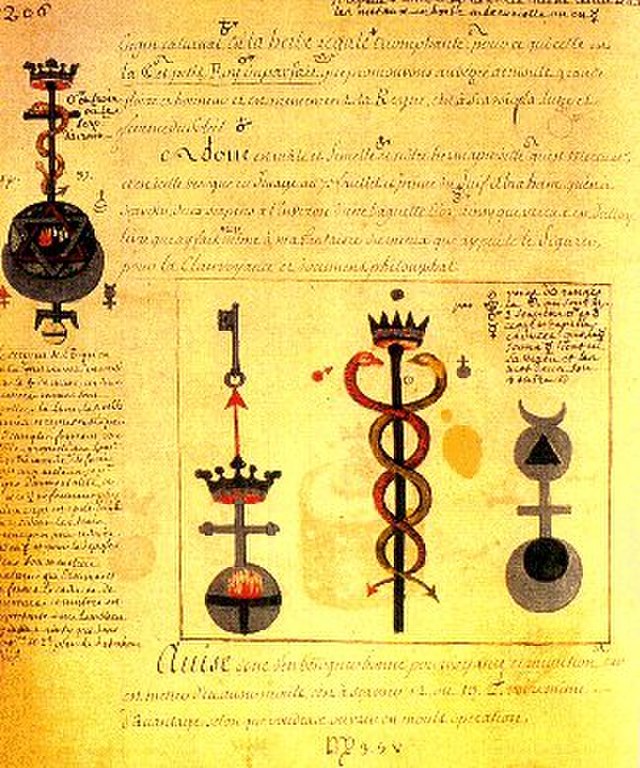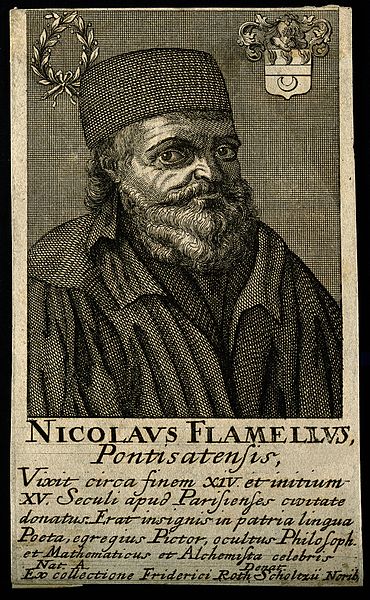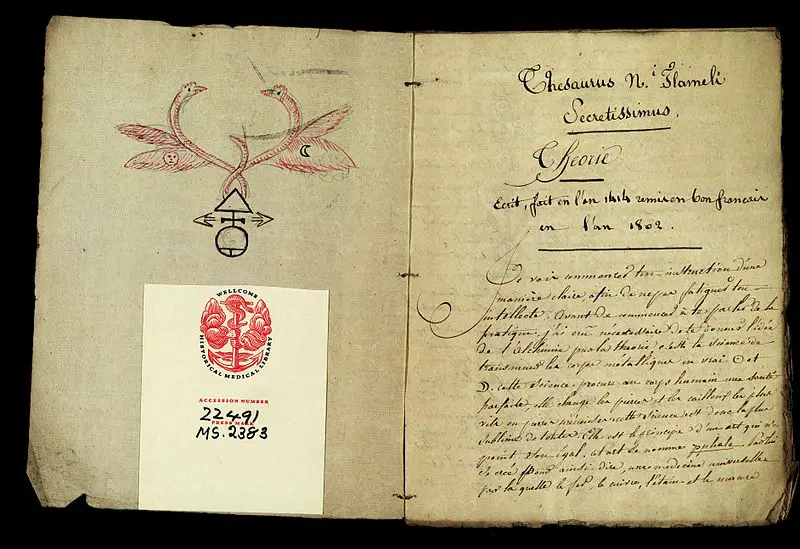 1919, the British physicist Ernest Rutherford announced that he had succeeded in transforming one element into another: nitrogen into oxygen. Although his research had nothing to do with alchemical processes, he proved that transmutation was possible and aroused new curiosity about the old alchemical statement that gold could be produced in the laboratory.
1919, the British physicist Ernest Rutherford announced that he had succeeded in transforming one element into another: nitrogen into oxygen. Although his research had nothing to do with alchemical processes, he proved that transmutation was possible and aroused new curiosity about the old alchemical statement that gold could be produced in the laboratory.
The following story is one of the most fascinating alchemist stories.
Nicolas Flamel, born in 1333, was a poor Parisian scribe and manuscript seller who married Perenelle, ten years his senior, whose two previous husbands died, leaving her a considerable fortune which she brought to her marriage to Flamel. Curious about science and magic, Perenelle became Flamel’s right hand, assistant, and advisor in all his endeavors.
Later in their marriage, they suddenly became so wealthy that they donated a lot of money to Paris and built churches, hospitals, and houses for the homeless. Even the king ordered an investigation into their source of money but found nothing at all.
Nicolas Flamel wrote an alchemical notebook, The Treasures of Treasures, the only copy of which dates from the 18th century, three centuries after Flamel’s death, and is preserved in the archives of the Science Museum in Paris.
Today a Paris street near the Louvre Museum bears his name, Rue Nicolas Flamel, and intersects with Rue Perenelle, named after his wife.
It all started with a rare book
One day a dark, mysterious stranger came into Flamel’s bookshop and sold him an old illuminated manuscript, the binding of which was of brass, well bound, and all embossed with letters of strange figures, which were neither French nor Latin. Inside, text was engraved on bark leaves with an iron pencil or graver, curiously colored, and provided with many illustrations and symbols.
Flamel found that the book was mostly written in Greek and Hebrew, so he spent 21 years learning them and trying to decipher the manuscript. The first page was written in gold letters saying that Abraham, the Jew, Priest, Prince, Levite, Astrologer, and Philosopher wished health to the Jewish people scattered in France by the wrath of God. Flamel recognized it was the Book of Abraham the Jew. The dedication was followed by curses on anyone who read the book, whether priest or Jew. But Flamel was a scribe and didn’t think the rule applied to him that much, so he continued his studies. The purpose of the book was explained to help the scattered Jews by teaching them how to turn lead into gold so they could pay their taxes to the hated Roman government.
The instructions were clear and simple but only described the last part of the process. The opening instructions were in the illustrations on pages 4 and 5 of the book. Flamel realized that his limited knowledge of both Jewish books and their Qabalah will not be sufficient to understand the entire manuscript and he needed to find someone who could translate it for him. Finally, after 21 unsuccessful years, Perenelle persuaded him to go to Spain and seek out a rabbi or other learned Jew who could help him.

Pilgrimage to the shrine of St. James at Compostela
Flamel made a copy of the first few pages and took it with him on the pilgrimage to the shrine of St. James in Compostela, where he held devotions and then went to the city of León in northern Spain. There he finally met a Jewish doctor, Master Canches, who recognized the manuscript as a book that had long been believed to have been destroyed.
Master Canches then translated the first few pages before agreeing to travel back to France and translate the rest. Unfortunately, on the journey to Orleans, he fell ill and died. Flamel returned to Paris alone. But the old Jew had taught him enough and Flamel was able to complete the translation on his own over the next three years.
He wrote: “I now had the prima materia, the first principles, but not their first preparation, which is the most difficult thing in the world… At last, I found what I desired, what I also knew through the strong Scent and smell of it. With this I easily attained mastery… The first time I made a projection [transmutation] was on Mercury, of which I turned about half a pound into pure silver, better than that of the mine as I did examine himself and had others examined many times, this was at about noon on a Monday, January 17, at my house, in the year of restoring the mankind 1382., only Perrenelle present.”
Some months later Flamel led his first transmutation to gold.
Is this just a story?
What the Paris records state is that after 1382 Nicolas and Perenelle Flamel endowed the city with fourteen hospitals, three chapels, and seven churches, all built from scratch and enriched with great gifts and revenues, with many indemnities in the church meters. They also donated as much to Boulogne while constantly conducting charity drives for poor people, especially widows and orphans.
Nicolas and Perenelle are depicted on the portal of the Chapel of St James of the Boucherie praying at the feet of St John, a sculpture they sponsored in 1389. Perenelle died in 1397, leaving Nicolas a sum of 5,300 tours pounds, which would be worth $800,000 today. But the sum was then challenged in court by her sister and brother-in-law who won. In 1410, Flamel designed his own tombstone, carved with the images of Christ, St Peter, and St Paul, which is now kept in the Musée de Cluny in Paris. Records state that he died in 1418 or 1419.
After his death, many believed he was still alive and the same was true of Perenelle who actually went to Switzerland and he buried a log in her grave, and then another log was buried at his own funeral. People kept searching all of their houses to find anything that would explain the mystery and luxury surrounding Flamels until they completely destroyed one of the houses.

The Philosopher’s Stone
Tales of alleged encounters with the Flamels continued, and for centuries past everyone seemed convinced that Flamel and Perenelle had found the Philosopher’s Stone and conquered death.
The 17th-century traveler Paul Lucas, on a journey through Asia Minor, met a Turkish philosopher who told him that true philosophers had the secret of extending life by up to a thousand years. Lucas mentioned Nicolas Flamel and his legend, which clearly disproved historical evidence, but the Turkish philosopher smiled at his simplicity and asked with a touch of hilarity if he really believed it.
He then said convincingly that Flamel still lives like his wife and that he spent some time with them in India only three years ago. Nicolas was actually one of his best friends. In 1761, Flamel and his wife are said to have been seen visiting the Opera in Paris.
In the 19th and 20th centuries, Flamel appears in works of art such as Victor Hugo’s The Hunchback of Notre Dame, Eric Satie’s notebooks, and Umberto Eco’s Foucault Pendulum while Freemason Albert Pike mentions him in his book Morals and Dogma, a philosophical rationale of Freemasonry. It is also well known that Isaac Newton was very interested in alchemy and had his own share of Flamel stories.
The idea of mastering life and death and being self-sufficient in terms of money and resources is as old as the world and the first prosperous civilizations. Saying whether this is possible or not is truly a philosophical question as well as a matter of privacy.

Writer and director who thinks different and does everything differently. Art enthusiast. Wandering and wondering. Until the end of meaning.
irena_curik@hotmail.com





